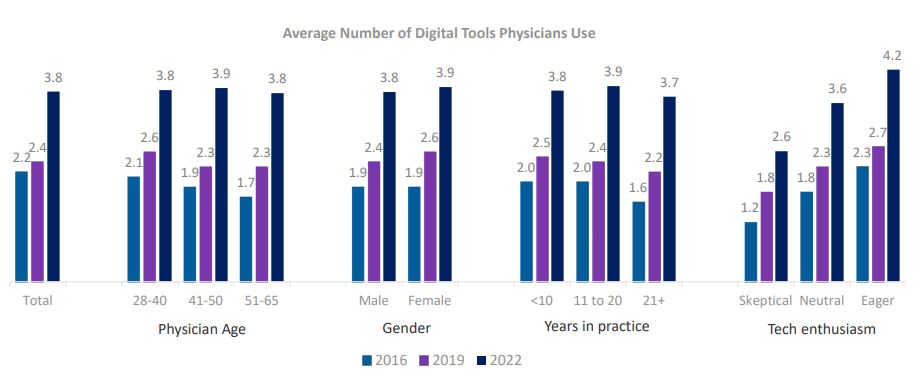An AMA report out this month surveys physicians regarding their perceptions of digital health. This year’s survey replicates similar surveys in 2016 and 2019. Some of the key findings are:


- There has been an increase in the percentage of physicians that feel there are advantages in leveraging digital health solutions. The percentage of physicians who feel digital health tools are an advantage for patient care grew from 85% in 2016 to 93% in 2022, and increases were measured across all physicians regardless of age or specialty.
- Adoption of digital tools has grown significantly among all physicians regardless of gender, specialty, or age. The average number of digital health tools in use by a physician grew from 2.2 in 2016 to 3.8 in 2022.
- Improved clinical outcomes and work efficiency are the top factors influencing physician interest in digital health tools. The ability to help reduce stress and burnout has also gained importance as a key driver of digital tool adoption. Liability coverage remains the most important requirement for physician adoption of digital health tools followed by integration with their EHR and assurances for data privacy.
- The largest growth in adoption was among digital health tools that aid in remote care. The percentage of physicians using tele-visits/virtual visits grew from 14% in 2016 to 80% in 2022 while the percentage of physicians using remote monitoring devices grew from 12% in 2016 to 30% in 2022.
- The digital health tools that garner the most enthusiasm among physicians are tele-visits (57%) followed by remote monitoring devices (53%).
- Intentions are high for the future adoption of emerging technologies, but current usage is low.
- Two in 5 physicians plan to adopt augmented intelligence in the next year, while nearly 1 in 5 physicians are currently using augmented intelligence in their practices. While current usage of digital therapeutics is low, they have the highest percentage of planned incorporation in the future.
You can read more about these results here.

